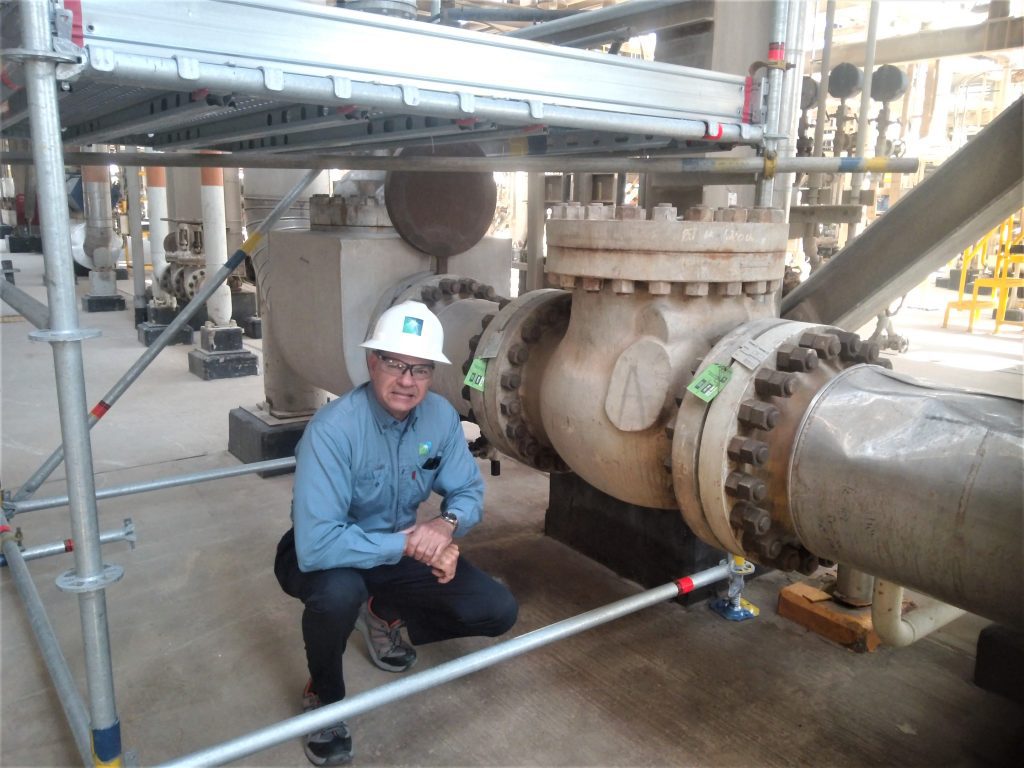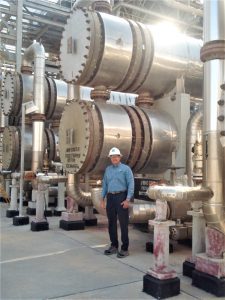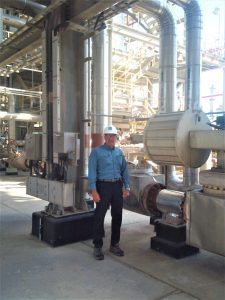Miguel Gutierrez is a mechanical engineer with over 30 years of experience in the oil and gas industry, including 18 years at Saudi Aramco. We spoke with Miguel to gain his insights the challenges, trends, and evolution of valve selection and maintenance.
By Melonie Dodaro, Valve World
Miguel Gutierrez is a highly experienced mechanical engineer who has dedicated his career to the oil and gas industry. With over 30 years of experience, including 18 years at Saudi Aramco, Miguel has established himself as an expert in stationary equipment engineering. Throughout his career, he has focused on providing technical support and expertise in valve selection, maintenance, and troubleshooting for various applications in the oil and gas sector, particularly in the downstream segment.
Miguel graduated as a mechanical engineer in 1992 in Venezuela. “From the very beginning, I was passionate about working in the oil and gas industry. Fortunately, I had the opportunity to pursue my dream immediately after graduation.
I interviewed with the Venezuelan National Oil Company and was accepted right away, allowing me to start my career in this field. I truly enjoy my work and have always wanted to specialize as a stationary equipment engineer,” says Miguel.
Current role and responsibilities at Saudi Aramco
“Currently, I work as a field engineering consultant specializing in stationary equipment. As you may know, stationary equipment encompasses a wide range of components, including pressure vessels, heat exchangers, piping, valves, and other related items. My primary role is to provide technical support and expertise to Saudi Aramco’s facilities and affiliates, both within the Kingdom and overseas.”
“Prior to my current position, I was a stationary equipment specialist, focusing on providing technical support to the Ras Tanura Refinery. In fact, I spent most of my career at this refinery, developing my expertise and contributing to its operations.”
Challenging valve applications in the oil & gas industry
“When selecting the right type of valve for a particular application, several key parameters must be considered:
- Fluid service: The type of fluid passing through the valve (gas, liquid, or slurry)
- Process conditions: Factors like temperature, pressure, and flow rate
- Mode of operation and function: On/off, throttling, or control
- Materials of construction: Compatibility with the fluid and operating environment
- Maintenance requirements: Ease of servicing and repairing the valve
These factors are crucial in determining the most suitable valve for a given situation.”
“In the oil and gas industry, particularly in the downstream section (refining), I have encountered some of the most challenging applications throughout my career in the selection and troubleshooting of low-performance dual plate check valves on compressor discharge piping. These valves play a vital role in preventing backflow and protecting the compressor, but their performance can be affected by various factors such as pulsation, vibration, and improper installation. Addressing these issues requires a thorough understanding of the system dynamics and the valve’s design characteristics.”
For example, just recently, we faced chronic check valve malfunction issues at the discharge of critical vacuum bottom pumps at one important refinery. These check valves experienced internal passing, and after disassembly, the disc was found seized due to the accumulation of hard deposits. After conducting extensive troubleshooting and performing hydraulic evaluations along with a comprehensive assessment of the system and valve dynamic characteristics to verify it was operating in the “non-slam” region and the pressure surge due to reverse velocity did not exceed the line maximum allowable working pressure (MAWP), it was concluded that the existing 18” swing-type check valve was oversized. As such, it would not operate steadily at the current flow rate conditions, leading to plugging, premature wear, and failure of internal components such as the disc, swing arm, and hinge pin.

Trends in addressing valve selection and maintenance challenges
“Yes, I have noticed several trends in recent years when it comes to handling these challenges.”
“Firstly, the majority of the most recognized valve manufacturers worldwide have significantly enhanced their valve design capabilities. They have focused on developing alternative solutions that help mitigate failures and resolve issues related to low valve performance, as reported by end users. These design improvements have been crucial in addressing the challenges faced in various applications.”
“In addition to valve design improvements, there are other important aspects to consider when overcoming these challenges. One key factor is establishing effective maintenance strategies, such as predictive maintenance and preventive maintenance (PM) intervals. These strategies are intended to optimise valve performance and ultimately extend the valve’s service life. By implementing these maintenance practices, we can proactively address potential issues and ensure the valves continue to operate reliably.”
“In fact, one of the papers I submitted, which was published in Valve World, specifically focused on best maintenance strategies for critical valves. The paper highlighted the importance of adopting a comprehensive approach to valve maintenance, considering factors such as operating conditions, materials of construction, and the criticality of the application.”
 Evolution and advancements in check valve selection
Evolution and advancements in check valve selection
“When it comes to the proper selection of check valves, one of the most significant developments in the last decade has been the incorporation of mathematical equations to determine the system’s dynamic characteristics. This involves calculating the system deceleration and expected reverse velocity to ensure that the selected valve operates within the non-slam region and that the pressure surge is limited to an acceptable level.”
“In my experience, when troubleshooting check valves that are not performing well, such as those exhibiting unsteady operation, fluttering, or chattering causing excessive noise, the first aspect I examine is the system hydraulics, including pressure drop and velocity. I also analyse the system dynamics, which involves reviewing the deceleration curves provided by the valve manufacturer. Additionally, I assess the check valve installation and layout to determine whether the valve has been properly selected for the specific application.”
“By conducting a thorough analysis of these factors, it becomes possible to identify the root cause of the check valve’s poor performance. This analysis helps determine whether the issue stems from improper valve selection, suboptimal installation, or a mismatch between the valve’s characteristics and the system’s requirements.”
“The evolution in check valve selection has been driven by a growing understanding of the importance of considering system dynamics and hydraulic conditions. Manufacturers have responded by providing more detailed data and tools to assist in the selection process, enabling engineers to make more informed decisions and minimize the risk of valve failure or suboptimal performance.”
Non-slam check valves: working principles, applications, and advantages
“A check valve must operate in a way that avoids the formation of excessively high surge pressure when the valve closes and limits rapid fluctuating movements of the valve closure member, which is known as slamming. These rapid fluctuations or sudden closure can damage the valve internals, subsequently affecting the valve’s performance. In some cases, it might also compromise the integrity of the associated piping system.”
“Non-slam check valves are designed to close without slamming, which means they do not create excess pressure surges. These valves have a limited short stroke, which facilitates soft closing quickly in the event of a sudden reduced flow, effectively preventing pressure surges.”
“One of the primary advantages of non-slam check valves is their ability to prevent pressure surges effectively. By doing so, they eliminate any resultant pressure fluctuations, vibration, and potential damage to the associated piping system. This makes non-slam check valves particularly valuable in applications where sudden flow changes are expected, and system integrity is crucial.”
“In the oil and gas industry, particularly in refining, non-slam check valves are commonly used in various applications. These include high head multi-pump systems, centrifugal/reciprocating compressor piping discharge systems, high back pressure – low inertia pumps, and boiler feedwater systems, among others. In these applications, the use of non-slam check valves helps ensure smooth operation, minimizes the risk of system damage, and extends the overall service life of the valves and associated equipment.”
Evolutions and enhancements in non-slam check valve design
“There are different types of non-slam check valves, with the most common and widely used being:
- Dual plate check valves
- Nozzle or axial flow type check valves
- Tilting disc check valves”
“For each type or category, recognized valve manufacturers worldwide have substantially enhanced their valve designs by using advanced tools such as computational fluid dynamics (CFD), finite element analysis (FEA), and flow test benches. The ultimate objective of these enhancements is to improve the valve’s dynamic performance, sealing capabilities, and the resistance of internal parts against reverse flow.”
“These tests and simulations recreate different scenarios where the valve internals’ design and configuration are slightly modified until an optimum design is achieved to satisfy the valve’s dynamic performance requirements.”

Strategies for valve manufacturers to become preferred suppliers for end users
“As end users, one of the challenges we often face is the need for effective communication and technical support from valve manufacturers, especially when troubleshooting valves that are not performing optimally. In these situations, we collect data and consult directly with the valve manufacturer to find alternative solutions. However, sometimes the communication channels and technical support provided by the manufacturers do not meet our expectations, leaving room for improvement.”
“To become a preferred supplier, valve manufacturers should prioritize responsiveness to end users’ requests, particularly when it comes to field troubleshooting activities. Providing timely and comprehensive technical support is crucial in helping end users resolve issues efficiently and minimize downtime.”
“Another critical aspect is the availability of spare parts. End users often encounter difficulties in procuring critical spare parts, especially for valves that have become obsolete or have been discontinued by the manufacturer. Valve manufacturers should strive to maintain an adequate inventory of spare parts or provide alternative solutions to ensure end users can properly maintain and repair their valves, even for older models.”
Collaboration and continuous improvement in the valve industry
Miguel Gutierrez’s insights throughout this interview have highlighted the importance of collaboration between end users and valve manufacturers in addressing the challenges faced in valve selection and maintenance. By prioritizing effective communication, providing prompt technical support, and ensuring the availability of critical spare parts, valve manufacturers can establish themselves as reliable partners for end users. As the oil and gas industry continues to evolve, it is essential for both end users and valve manufacturers to work together to optimize valve performance and longevity. By staying informed about the latest developments in valve technology and best practices, and by maintaining open lines of communication, both parties can contribute to the continuous improvement of the valve industry.
Through shared knowledge and experiences, such as those provided by Miguel Gutierrez, the valve industry can continue to innovate and adapt to the ever-changing needs of the oil and gas sector, ultimately ensuring the safe, efficient, and reliable operation of facilities worldwide.
About this Featured Story
This Featured Story is an article from our Valve World Magazine, August 2024 issue. To read other featured stories and many more articles, subscribe to our print magazine. Available in both print and digital formats. DIGITAL MAGAZINE SUBSCRIPTIONS ARE NOW FREE.
“Every week we share a new Featured Story with our Valve World community. Join us and let’s share your Featured Story on Valve World online and in print.”



 Evolution and advancements in check valve selection
Evolution and advancements in check valve selection